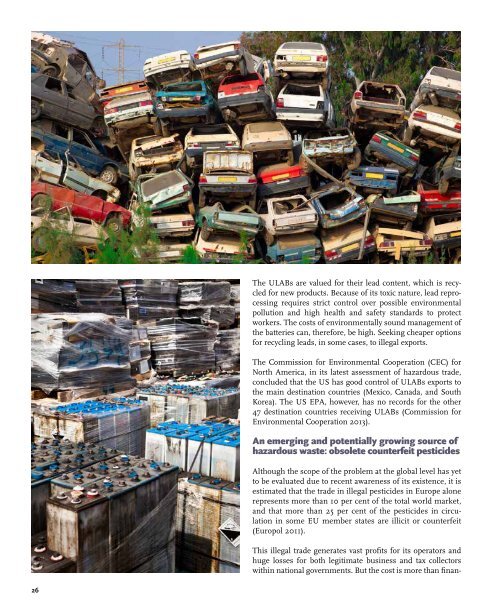WASTE CRIME – WASTE RISKS
6VhhXcA80
6VhhXcA80
Create successful ePaper yourself
Turn your PDF publications into a flip-book with our unique Google optimized e-Paper software.
The ULABs are valued for their lead content, which is recycled<br />
for new products. Because of its toxic nature, lead reprocessing<br />
requires strict control over possible environmental<br />
pollution and high health and safety standards to protect<br />
workers. The costs of environmentally sound management of<br />
the batteries can, therefore, be high. Seeking cheaper options<br />
for recycling leads, in some cases, to illegal exports.<br />
The Commission for Environmental Cooperation (CEC) for<br />
North America, in its latest assessment of hazardous trade,<br />
concluded that the US has good control of ULABs exports to<br />
the main destination countries (Mexico, Canada, and South<br />
Korea). The US EPA, however, has no records for the other<br />
47 destination countries receiving ULABs (Commission for<br />
Environmental Cooperation 2013).<br />
An emerging and potentially growing source of<br />
hazardous waste: obsolete counterfeit pesticides<br />
Although the scope of the problem at the global level has yet<br />
to be evaluated due to recent awareness of its existence, it is<br />
estimated that the trade in illegal pesticides in Europe alone<br />
represents more than 10 per cent of the total world market,<br />
and that more than 25 per cent of the pesticides in circulation<br />
in some EU member states are illicit or counterfeit<br />
(Europol 2011).<br />
This illegal trade generates vast profits for its operators and<br />
huge losses for both legitimate business and tax collectors<br />
within national governments. But the cost is more than finan-<br />
26


